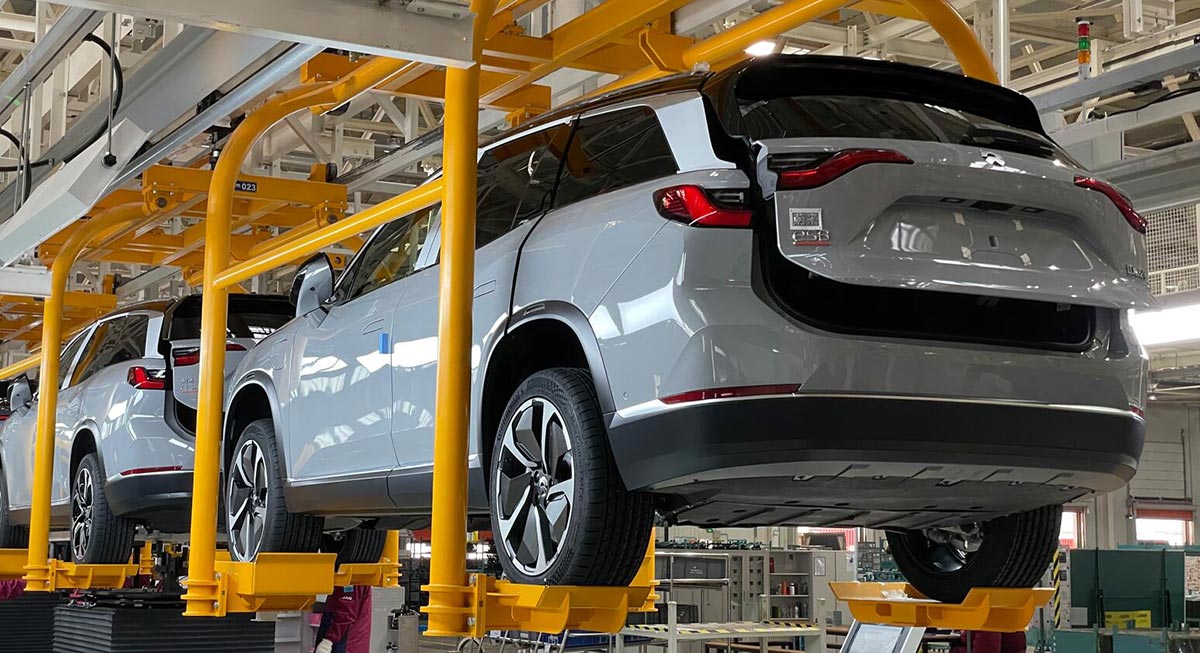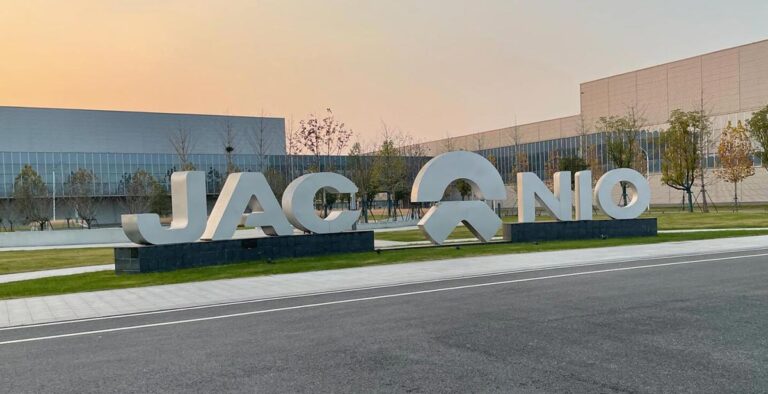Nio pays JAC for each vehicle produced on a per-vehicle basis monthly. It paid JAC an average of about $1,260 per vehicle in 2022.
(Image credit: CnEVPost)
Nio's (NYSE: NIO) vehicle manufacturing partner JAC announced last week that it plans to sell the assets of two factories that produce vehicles for the electric vehicle (EV) carmaker.
Subsequent reports suggested that Nio could acquire those assets and move from contract manufacturing to independent production for greater self-reliance.
These developments have left many wanting to know the details of Nio's partnership with JAC, and CnEVPost has found some valuable information after digging into Nio's 2022 annual report.
The following is all from the English version of Nio's 2022 annual report, some of which may be repeated as they are used in different places.
The first part of it, covering JAC in the most detail, is a risk-related statement, which usually lists all the worst-case scenarios.
The final section in this article lists the vehicle manufacturing fees paid by Nio to JAC, though there appears to be some typos in the numbers mentioned in the English texts, with three zeros missing.
Those numbers are correct in Nio's Chinese-language 2022 annual report, which said it paid JAC RMB 531 million, RMB 715 million, and RMB 1.12 billion from 2020 to 2022, respectively.
Nio's annual deliveries of 43,728, 91,429, and 122,486 in 2020-2022 mean that the company paid JAC an average of RMB 12,156, RMB 7,822, and RMB 9,197 ($1,260) per vehicle in those three years.
Nio pays JAC on a monthly basis for each vehicle produced, according to the report.
The following are extracts from Nio's 2022 annual report in English by CnEVPost.
From page 24:
Manufacturing in collaboration with partners is subject to risks.
We partner with Jianghuai Automobile Group Ltd., or JAC, a major state-owned automobile manufacturer in China, for the joint manufacturing of our vehicles.
JAC jointly manufactures with us all of our current vehicle models, including the ES8, the ES7 (or the EL7), the ES6, the EC7, the EC6, the ET7 and the ET5, in the first advanced manufacturing base, or the F1 Plant, and the second advanced manufacturing base, or the F2 Plant, and will jointly manufacture with us our other vehicle models in the F2 Plant.
For the years ended December 31, 2020, 2021 and 2022, we paid JAC for each vehicle produced on a per-vehicle basis monthly.
Pursuant to the joint manufacturing arrangements we entered into with JAC, as amended and renewed, JAC and us jointly manufacture a series of our vehicle models in the F1 Plant.
We are in charge of vehicle development and engineering, supply chain management, manufacturing techniques and quality management and assurance.
Jianglai Advanced Manufacturing Technology (Anhui) Co., Ltd., or Jianglai, a joint venture for operation management established by JAC and us, who joined as a party to the joint manufacturing arrangements in May 2021, is responsible for parts assembly and operation management.
Pursuant to the manufacturing cooperation agreements we entered into with JAC in September 2022, JAC will jointly manufacture with us the ET5 and potentially our other vehicle models in the F2 Plant.
We will be in charge of relevant trademarks and related technologies license, vehicle specifications, parameters and option requirements, as well as raw materials supply.
In relation to the manufacturing cooperation agreements, we also entered into an assets transfer agreement and its supplementary agreement with JAC on December 23, 2022, under which we would transfer to JAC certain equipment and other assets.
Collaboration with third parties for the manufacturing of vehicles is subject to operational risks that may be beyond our control.
We could experience production and delivery delays to the extent our partners do not meet agreed-upon timelines or experience capacity constraints.
The volume of vehicles manufactured could fall short of expectation if there is any adverse change in our partners’ liquidity position or overall operations that causes their inability to meet their contractual manufacturing obligations.
There is risk of potential disputes with partners, and we and our brand image could be affected by adverse publicity or public sentiment towards our partners whether or not such publicity or public sentiment is related to their collaboration with us.
In addition, although we are involved in each step of the supply chain and manufacturing process, given that we also rely on our partners to meet our quality standards, there can be no assurance that we will successfully maintain quality standards.
Our joint manufacturing arrangement with JAC for the vehicle manufacturing in the F1 plant will expire in May 2024, and our manufacturing cooperation agreement with JAC for the vehicle manufacturing in the F2 plant will expire in September 2025, upon which, respectively, we will need to renew the relevant contract with JAC or locate other manufacturing partners.
We may be unable to enter into new agreements or extend existing agreements with JAC and other third-party manufacturing partners on terms and conditions acceptable to us.
If that happens, we may need to significantly enhance our own production capacity, and there is substantial uncertainty on our ability to achieve that and the timetable related thereto.
The expense and time required to complete any transition, and to assure that vehicles manufactured at facilities of new third-party partners, or at our own facilities if we choose to enhance our own production capacity, comply with our quality standards and regulatory requirements, may be greater than anticipated.
From page 65:
If we update our manufacturing equipment more quickly than expected, we may have to shorten the useful lives of any equipment to be retired as a result of any such update, and the resulting acceleration in our depreciation could negatively affect our financial results.
We and JAC have invested and expect to continue to invest significantly in what we believe is state of the art tooling, machinery and other manufacturing equipment for the product lines where the vehicles are manufactured, and we depreciate the cost of such equipment over their expected useful lives.
However, manufacturing technology may evolve rapidly, and we or JAC may decide to update our manufacturing process with advanced equipment more quickly than expected.
Moreover, as our engineering and manufacturing expertise and efficiency increase, we or JAC may be able to manufacture our products using less of our installed equipment.
The useful life of any equipment that would be retired early as a result would be shortened, causing the depreciation on such equipment to be accelerated, and to the extent we own such equipment, our results of operations could be negatively impacted.
Furthermore, under the renewal joint manufacturing arrangement we entered into with JAC and Jianglai in May 2021 and under the manufacturing cooperation agreement we entered into with JAC in September 2022, we agreed to pay JAC the asset depreciation and amortization with regard to the assets JAC invested and to invest for the manufacture of our vehicle models as actually incurred, payable monthly and annually, respectively, and subject to adjustment annually.
An increased amount of investment made by JAC into the manufacturing plants will lead to an increased cost in asset depreciation and amortization, which could negatively affect our results of operations and financial conditions.
From page 129:
Vehicle Manufacturing
We partner with JAC for the joint manufacturing of our vehicles. JAC jointly manufactures with us all of our current vehicle models, including the ES8, the ES7 (or the EL7), the ES6, the EC7, the EC6, the ET7 and the ET5, in the F1 Plant and the F2 Plant, and will jointly manufacture with us our other vehicle models in the F2 Plant.
The annual production capacity of each of the F1 Plant and the F2 Plant can be expanded to up to 300,000 units (calculated based on 5,000 working hours per year).
Pursuant to the joint manufacturing arrangements we entered into with JAC, as amended and renewed, JAC jointly manufactures with us a series of our current vehicle models, and will jointly manufacture with us our other vehicle models, in the F1 Plant.
We are in charge of vehicle development and engineering, supply chain management, manufacturing techniques and quality management and assurance. Jianglai, who joined as a party to the joint manufacturing arrangements in May 2021, is responsible for parts assembly and operation management.
Pursuant to the manufacturing cooperation agreements we entered into with JAC in September and December 2022, respectively, JAC jointly manufactures with us the ET5 and potentially our other vehicle models in the F2 Plant. We are in charge of relevant trademarks and related technologies license, vehicle specifications, parameters and option requirements, as well as raw materials supply.
From page 351:
Manufacturing in collaboration with JAC
Since 2016, the Group have been partnering with Jianghuai Automobile Group Ltd., or JAC, a major stateowned automobile manufacturer in China, for the joint manufacturing of the Group’s vehicles.
JAC built the JAC-Nio manufacturing plant in Hefei, Anhui province, the first advanced manufacturing base, or the F1 Plant, for the production of the ES8, the ES6, the EC6, the ET7 and potentially the Group’s other vehicle models.
Further, in September 2022, the Group entered into a manufacturing cooperation agreement with JAC, under which JAC will jointly manufacture the ET5 and potentially the Group’s other vehicle models in the second advanced manufacturing base, or the F2 Plant, in NeoPark, a smart electric vehicle industry park at Xinqiao, Hefei.
The fees payable to JAC under the above agreements consist of the following:
(i) asset depreciation and amortization with regard to the assets JAC invested and to invest for the manufacture of Nio models as actually incurred, payable monthly and subject to adjustment annually;
(ii) vehicle production and processing fees recorded on per-vehicle basis, payable monthly and subject to adjustment annually;
(iii) purchase amount of certain production materials;
and (iv) relevant tax. In addition, the Group also agreed to pay certain compensation up to a capped amount for JAC’s investment in F1 Plant, including for the land, factory and equipment.
In conjunction with the aforementioned manufacturing cooperation agreement, in December 2022, the Group and JAC entered into an Asset Transfer Agreement where the Group agreed to sell and JAC agreed to acquire certain production facilities (the “Transferred Assets”) with a total consideration of RMB1.7 billion inclusive of tax. As of December 31, 2022, JAC had accepted the Transferred Assets and assumed the legal title of the Transferred Assets.
Considering that (1) the Transferred Assets are designated to be used for the manufacturing of the Group’s vehicle models only and do not have substantive alternative use; (2) all costs incurred in relation to the Transferred Assets, including depreciation and maintenance costs and relevant tax and surcharges, are undertaken by and charged to the Group; (3) the Group also has the right to obtain the economic benefits from all outputs of the Transferred Assets, management concluded that the Group still retained the control of the Transferred Assets and this transaction was a failed sale and leaseback transaction with no sales of the Transferred Assets recognized by the Group.
The Transferred Assets continue to be accounted for as the Group’s property, plant and equipment subject to depreciation. The sales consideration from JAC will be recorded as a financing payable when the Group receives the cash.
As of the date of issuance of this financial statements, JAC had not paid the consideration.
For the years ended December 31, 2020, 2021 and 2022, the aggregate fees to JAC under the above collaboration arrangement were RMB 531,565, RMB 715,118 and RMB 1,126,523, respectively, and were included in cost of sales.
($1 = RMB 7.3174)


